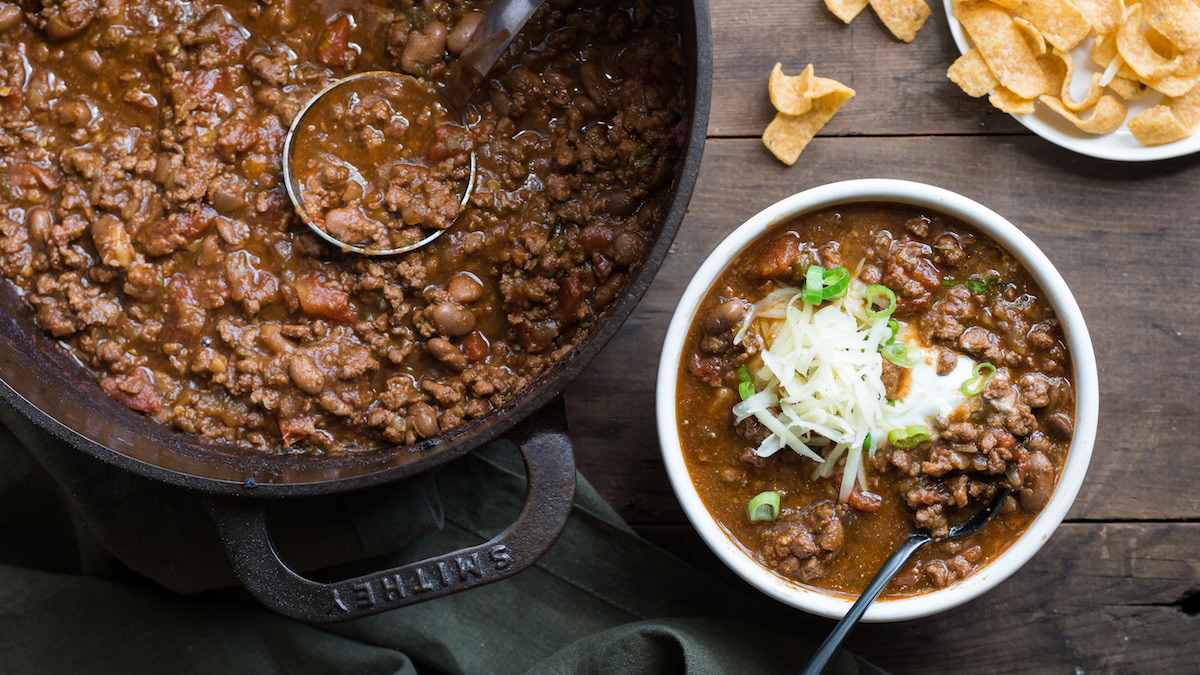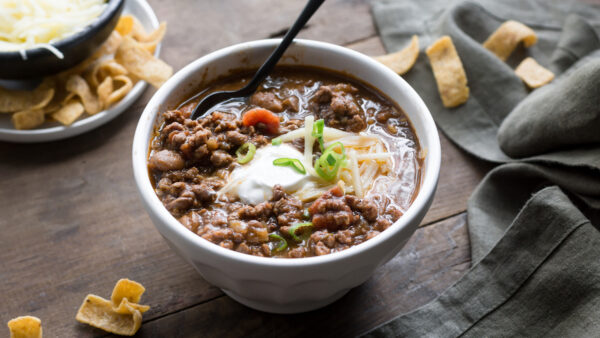
Course
Main
Duration
4 hours
Serves
4-6
The secret to making award-winning chili is knowing how to layer spices and concentrate flavors. This recipe relies on good seasoning, smoke, and time. I like to use coarse-ground venison for texture and the MeatEater Sabertooth Slayer Coffee Chili Rub for complexity and richness. Adding beans is optional, but if you do, choose charro.
As I said in my smoked venison jerky recipe, wood smoke type is dealer’s choice. Mesquite gives the strongest flavor and is my favorite for venison. Hickory, oak, and pecan are a little more subtle, but still offer plenty of taste. Sweet pellets like cherry and apple are the most mild. They’re better for things like turkey, hog, and fish.
Ingredients
- 2 tbsp. oil
- 2 lb. ground venison
- 1 medium onion, diced
- 3 hatch chiles, roasted and chopped (or 4 oz. canned green chiles)
- 4 cloves of garlic, minced
- 2 cups venison or beef stock
- 1/4 cup tomato paste
- 1 can fire-roasted, diced tomatoes (15 oz.)
- 1 can charro beans (15 oz.)
- 1 tbsp. Worcestershire sauce
- 1 tsp. smoked or plain sea salt
- 1 tbsp. MeatEater Sabertooth Slayer Coffee Chili Rub
- 1 tbsp. ancho or red chili powder
- Corn chips, sour cream, shredded cheese, and green onions for serving
Also works with
Special equipment
Preparation
- Prepare your smoker according to the manufacturer’s instructions using your choice of wood or pellets. Set a large Dutch oven inside the smoker and crank the heat to high, around 450 degrees. If you’re using an aluminum foil tray, there is no need to preheat the pan that long.
- Once the smoker has preheated and the cast iron is hot, pour in the oil and swirl to coat the pan. Add the ground venison in a single layer and close the lid on the smoker. Cook for 3-5 minutes and then stir. Continue to cook another 3-5 minutes until brown on all sides. Stir in the onion, chiles, and garlic.
- Close the lid on the smoker again and reduce the heat to 250 degrees. It will take time for the temperature to drop. While it does, let the meat absorb smoke for at least an hour. Stir occasionally.
- Pour in the stock, tomato paste, diced tomatoes, charro beans, Worcestershire, salt, coffee chili rub, and chili powder. Stir to fully combine, close the smoker’s lid, and cook for an additional two hours or longer to let the liquids reduce and intensify in flavor.
**Notes:
**Substitute the MeatEater Coffee Chili Rub with 1 tablespoon of chili powder, 1 teaspoon of kosher salt, 1 teaspoon of cumin, and a pinch of ground coffee. Include the additional 2 teaspoons of salt and 1 tablespoon of chili powder called for in the recipe.
If using a traditional smoker, it will be easiest to brown the venison and veggies in the firebox over direct heat first, and then transfer to the smoking chamber over indirect heat.
Sign In or Create a Free Account
Reviews
The secret to making award-winning chili is knowing how to layer spices and concentrate flavors. This recipe relies on good seasoning, smoke, and time. I like to use coarse-ground venison for texture and the MeatEater Sabertooth Slayer Coffee Chili Rub for complexity and richness. Adding beans is optional, but if you do, choose charro.
As I said in my smoked venison jerky recipe, wood smoke type is dealer’s choice. Mesquite gives the strongest flavor and is my favorite for venison. Hickory, oak, and pecan are a little more subtle, but still offer plenty of taste. Sweet pellets like cherry and apple are the most mild. They’re better for things like turkey, hog, and fish.
Ingredients
- 2 tbsp. oil
- 2 lb. ground venison
- 1 medium onion, diced
- 3 hatch chiles, roasted and chopped (or 4 oz. canned green chiles)
- 4 cloves of garlic, minced
- 2 cups venison or beef stock
- 1/4 cup tomato paste
- 1 can fire-roasted, diced tomatoes (15 oz.)
- 1 can charro beans (15 oz.)
- 1 tbsp. Worcestershire sauce
- 1 tsp. smoked or plain sea salt
- 1 tbsp. MeatEater Sabertooth Slayer Coffee Chili Rub
- 1 tbsp. ancho or red chili powder
- Corn chips, sour cream, shredded cheese, and green onions for serving
Also works with
Special equipment
Preparation
- Prepare your smoker according to the manufacturer’s instructions using your choice of wood or pellets. Set a large Dutch oven inside the smoker and crank the heat to high, around 450 degrees. If you’re using an aluminum foil tray, there is no need to preheat the pan that long.
- Once the smoker has preheated and the cast iron is hot, pour in the oil and swirl to coat the pan. Add the ground venison in a single layer and close the lid on the smoker. Cook for 3-5 minutes and then stir. Continue to cook another 3-5 minutes until brown on all sides. Stir in the onion, chiles, and garlic.
- Close the lid on the smoker again and reduce the heat to 250 degrees. It will take time for the temperature to drop. While it does, let the meat absorb smoke for at least an hour. Stir occasionally.
- Pour in the stock, tomato paste, diced tomatoes, charro beans, Worcestershire, salt, coffee chili rub, and chili powder. Stir to fully combine, close the smoker’s lid, and cook for an additional two hours or longer to let the liquids reduce and intensify in flavor.
**Notes:
**Substitute the MeatEater Coffee Chili Rub with 1 tablespoon of chili powder, 1 teaspoon of kosher salt, 1 teaspoon of cumin, and a pinch of ground coffee. Include the additional 2 teaspoons of salt and 1 tablespoon of chili powder called for in the recipe.
If using a traditional smoker, it will be easiest to brown the venison and veggies in the firebox over direct heat first, and then transfer to the smoking chamber over indirect heat.







